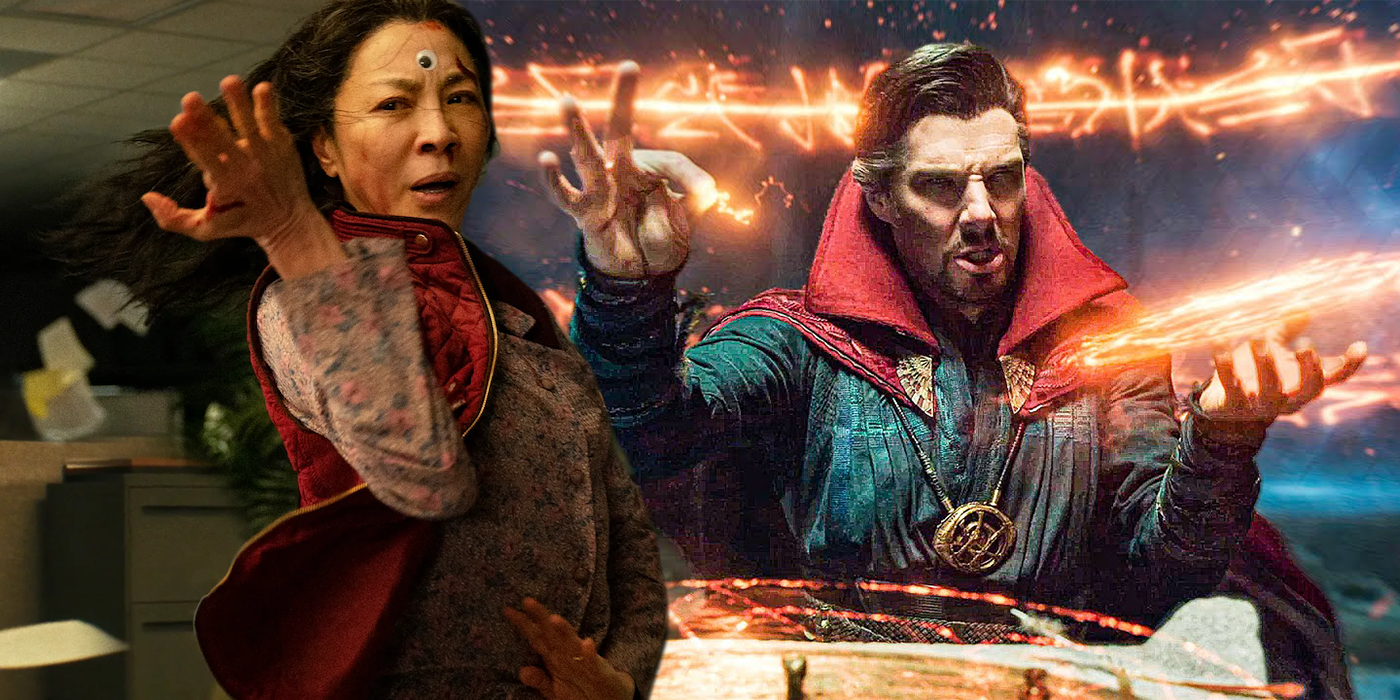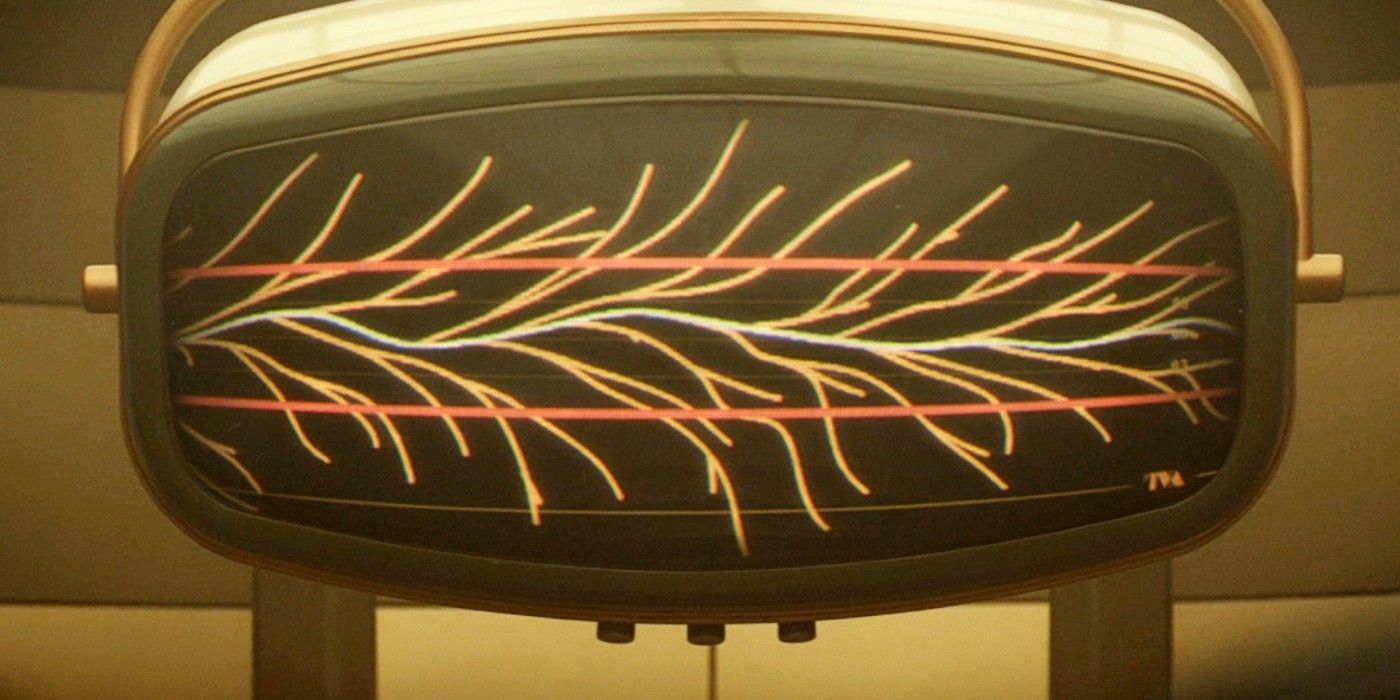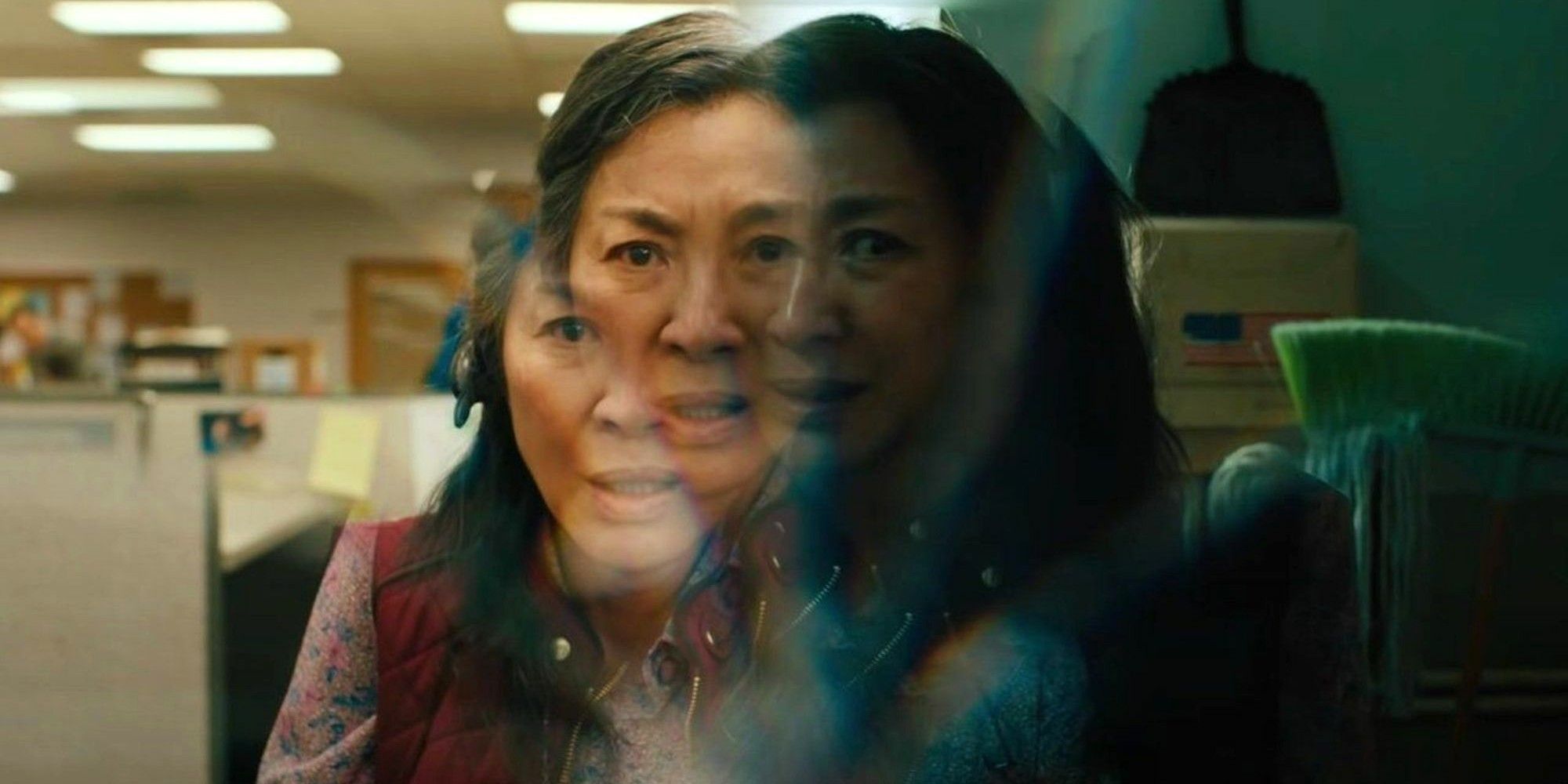Warning! This post contains spoilers for Everything Everywhere All At Once.
The daring use of the multiverse concept in Everything Everywhere All At Once arguably puts Marvel's multiverse to shame. The kaleidoscope of a film imagines Michelle Yeoh as a tired wife and mother busy trying to save her failing laundromat business and marriage when suddenly she learns that she is the only person who can save the multiverse. Everything Everywhere All At Once was directed by Daniel Kwan and Daniel Scheinhart, collectively known as Daniels, who previously directed the Daniel Radcliffe vehicle Swiss Army Man. It's also a comeback film for Ke Huy Quan, who acted as Short Round alongside Harrison Ford in Indiana Jones and the Temple of Doom. Quan plays Waymond Wang, the husband of Yeoh's character Evelyn. Everything Everywhere All At Once is a tour-de-force for Michelle Yeoh.
Multiverse movies have become extremely popular in the last few years. Spider-Man: Into the Spider-Verse, one of the best-received multiverse movies, won the Best Animated Feature Oscar in 2018. Both the DCEU and the MCU are expanding into their respective multiverses, Marvel's next multiversal movie being the upcoming Doctor Strange in the Multiverse of Madness. Despite some heavy hitters using multiverse concepts in their blockbusters, Everything Everywhere All At Once outdoes them by creating a multiverse that is whimsical and inventive but still manages to make sense. Evelyn and Waymond own a laundromat and are being audited by the IRS. While on their way to a meeting with an IRS inspector named Deirdre (Jamie Lee Curtis), Alpha Waymond takes over Waymond's body and warns Evelyn about a great evil that is bent on destroying the multiverse, an evil only she can stop. As it turns out, the evil is Jobu Tupaki, a multiverse version of her daughter Joy (Stephanie Hsu).
In truth, Everything Everywhere All At Once has done a much better job with its multiverse than the MCU has in its recent multiversal movies and streaming series. Marvel doesn't seem to have a unified idea of what its multiverse is and how it works. From Loki to Spider-Man: No Way Home, the rules seem to change each time there's a new project, which makes the continuity hard to follow. Everything Everywhere All At Once doesn't have those problems. In just two hours, Everything Everywhere All At Once manages to present a multiverse that shows Marvel's messy multiverse how it's done.
MCU's Multiverse Problems Explained
Marvel's Phase 4 has had more than one entry into the multiverse since it began, and that's part of the problem. In the Loki series, Marvel's branch timelines are explained, which is mostly in line with how they are explained in Avengers: Endgame. The TVA explains that there is a Sacred Timeline and that any deviation from that timeline will create a branch, which He Who Remains says is dangerous. However, in What If...?, the multiverse is shown to be made up of infinite realities that don't necessarily branch off from the so-called Sacred Timeline. The same seems to be true for the Spider-Man: No Way Home multiverse. The problem is that all three of these MCU properties have different events that are explanations for having "broken" the multiverse. It's not clear whether Loki's branch timelines are equivalent to the vast multiverse described in What If...?, or if the three different versions of Peter Parker are variants or just different Peters from completely separate universes. It's also possible that He Who Remains wasn't being completely truthful about how the multiverse works in Loki, but even with his explanation being a lie, that doesn't explain how Tobey Maguire and Andrew Garfield fit into the multiverse that What If...? presented. Maybe the MCU can fix some of these problems in Doctor Strange in the Multiverse of Madness, but so far, Marvel has created a multiverse that isn't unified and doesn't make sense.
Everything Everywhere Avoids All Of Marvel's Multiverse Issues
For a movie that doesn't hold back in its exploration of the multiverse, Everything Everywhere All At Once fully understands its multiverse and how it works. Its rules are clearly established early on in the film. Alpha Waymond, the version of Evelyn's husband from the Alphaverse, explains that there's a vast multiverse created by tiny decisions made by individuals over the course of their lifetime. These decisions can lead to small differences or really big changes to their individual lives or even the world around them. The people in the Alphaverse can also travel throughout the multiverse by using Bluetooth-like headsets to launch their consciousness into another version of themselves, which also allows them to acquire that version's skills, similar to Jet Li's The One. Despite these rules, Everything Everywhere All At Once's multiverse also has few limitations on what the multiverse can be. There's a universe where everyone has hotdog hands, and one where no life ever formed on Earth, so everyone is a rock. This movie easily avoids the confusion of Marvel's multiverse by letting it be open to every possibility while still giving the characters clear rules on how it operates.
Why Everything Everywhere's Multiverse Is Better Than Marvel's
While Marvel is still trying to figure out exactly how the MCU multiverse works, the Everything Everywhere All At Once multiverse is well-constructed and works on a fundamental level. The origin of the universe jumping, the explanation for how it works, and even the "everything bagel" black hole are all explained well. The villain, Jobu Tupaki, is a version of Evelyn's daughter because Alpha Evelyn pushed her Joy too far while training her to universe jump. Evelyn is the only person who can defeat her because the Alpha version of her was the one to discover the multiverse and to create Jobu Tupaki. Though the Jobu Tupaki situation is also a metaphor for healing the relationship between a mother and a daughter, the conflict also helps to explain the way universe jumping works, especially because Jobu Tupaki is a being who can experience every timeline in every universe simultaneously. This film's multiverse is seamless, which makes it feel more grounded as if everything explained in the film is probable. It also doesn't rely on magic or superpowers to explain how the multiverse works. Everything Everywhere All At Once is just a pure sci-fi movie for 2022 and does not try to be anything else.
Marvel could learn from Everything Everywhere All At Once when it comes to creating a clear, concise multiverse. Where Marvel's multiverse has failed to be consistent between its series and movies, Everything Everywhere All At Once pretty much nails the multiverse concept. As a high-concept film, it could have been hard to follow, but instead, Evelyn's multiversal adventure to save her daughter uses the multiverse better than any other multiverse movie has so far.




